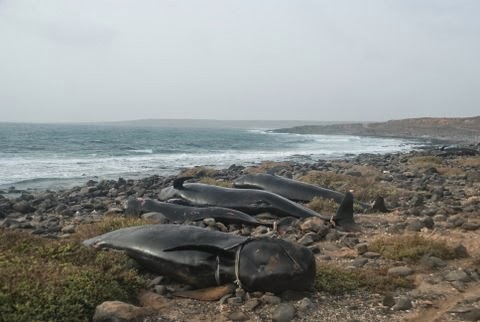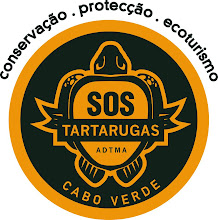Clique aqui para Português
On the morning of the 3rd July we received a call alerting us to the fact that some whales had been seen on the beach at Parda, which is in the north of the island close to Pedra de Lume. We contacted the team at our camp in nearby Ribeira de Tarrafe to go and assist them, but we had hardly finished talking to them before another call arrived – “Come quickly, bring as many people as you can – there are many whales on the beach at Kite Beach as well.”
On the morning of the 3rd July we received a call alerting us to the fact that some whales had been seen on the beach at Parda, which is in the north of the island close to Pedra de Lume. We contacted the team at our camp in nearby Ribeira de Tarrafe to go and assist them, but we had hardly finished talking to them before another call arrived – “Come quickly, bring as many people as you can – there are many whales on the beach at Kite Beach as well.”
 |
Two whales swim on to the shore again
© Diana Lin
|
The whole team dropped everything
and raced from Santa Maria and from our camp on Costa Fragata and when we
arrived, it was an incredible sight – so many people joined in this quest to
save these poor creatures.
We estimated that there were
twelve individuals, some adult and some juvenile. In addition, at least two pregnant females
were identified. The species was Short
Finned Pilot Whales (Globicephala macrorhynchus), a
species that is common in the waters around Cabo Verde. They can grow to an estimated 3,000kgs and
5.9m for males and for females 1,200kgs and 4m and feed predominantly on
squid. They are often seen in very large
groups. Although their common name is
‘whale’, they are, in fact, a member of the dolphin family.
The rescuers worked hard for almost eight hours, continually
pushing the whales back into the sea and swimming with them, holding them
upright until they could get past the very large waves and begin to swim
away. Unfortunately, several of them
would swim some of the way out before heading straight back into the shore
again. Rescue attempts were further
hampered by the rocky shoreline, which was causing danger for both the whales
and their human helpers.
Strandings of pilot whales are not uncommon in Cabo Verde as can
be seen from the historical picture below.
In the last few years, there have been at least two other
incidences of mass strandings.
In July 2010 42 individuals beached themselves in the Monte Leão
area and unfortunately no rescue was mounted until it was too late and all the
whales died. At the same moment there
was also a stranding on Santiago island.
 |
| A dead whale is removed for burial - Monte Leão |
In September 2012 around the same
number were found to be on Ponta Sinó on the southern part of Sal. Again a huge community effort resulted in
those whales being successfully refloated and returned to the sea. On the same day five whales also stranded on
Boa Esperança in Boa Vista, which is opposite Ponta Sinó and separated by only
40km of sea.
 |
|
Group of stranded whales Ponta Sinó Sal
island September 2012
|
 |
| A young pilot whale |
In this instance, all the whales were
successfully refloated and the rescue was made much easier than the recent one
because of the calmer conditions on the south part of Sal.
On Kite Beach, it was obvious that the
whales were exhausted from being thrown around in the waves and had hurt
themselves on the rocks, many were bleeding and unable to hold themselves
upright.
In the past, strandings of whales have been looked upon as an opportunity for food but this practice gives rise to many health concerns from the local authorities and it is definitely discouraged. Sadly, amongst all the rescuers present on the beach that day, one group decided to butcher a small whale in a particularly gruesome way while it was still alive.
 |
| Butchered whale Kite Beach Sal 3 July 2014 |
The reason why whales and dolphins strand
themselves is poorly understood. There
are many theories, including that the animal may be old or sick, it could be
infested with parasites or it simply becomes disoriented in shallow water. Boat noise, rapid changes in water pressure
from explosions, sonar or seismic testing may damage their very sensitive
sinuses and ears. This may prevent them
from diving as well as leading to navigational errors. Some theories include the desire to commit
suicide but this cannot be considered since there is no way to establish that
the animals plan their own death.
Strong social bonds may result in mass
strandings, with healthy animals unable to desert those that are on the beach.
In most cases in Cabo Verde, the animals
have been quickly removed and buried, with no chance to analyse possible
reasons, this has led to some conspiracy theories including covering up
military activities in the area. One of
the sonar systems thought to be used by US and NATO forces creates an amplitude
of 240 decibels – enough to kill whales and dolphins and a proven cause of mass
strandings.
On further analysis it transpires that two
pilot whales stranded on the west coast of Sal only one week before
And two pilot whales stranded and died on
Santa Luzia island two days prior, only a short distance from Sal.
Looking specifically at events in the area
during this time, two seismic surveys can be found, one of them only 420km
away. Evidence is mounting that this
type of survey is strongly linked with mass strandings.
http://www.sciencedaily.com/releases/2013/09/130925132211.htm
 |
|
Map showing seismic surveys in the area at
the time of the strandings.
Thanks to Stranded No More for the
information.
|
In the end, thanks to an incredible effort
from many people, all the pilot whales in the Kite Beach area were returned to
the sea. Unfortunately the five reported
further north all died. The most daring
rescue of all and the one that demonstrates the commitment of all involved, was
the transportation of the final two whales in the back of a pick up truck from
Costa Fragata to the calmer shore of Praia Antonio Sousa in the south. The two whales were lifted out of the water,
moved away from the dangerous rocks and picked up and put into the pick
up. Sheer strength and determination
overcame tiredness and despair and there were many tears of joy as the whales
finally swam away into open ocean.
 |
| © Giada Borghi |
Congratulations to everyone involved in the
events of this very dramatic day.











